 Back in 2000, Jamie Delano, wrote a nineteen issue series for Vertigo called Outlaw Nation with co-creator Goran Sudžuka. In 2006, Image and Desperado Publishing released a 456 page bound edition of the collected issues, printed in black and white. The series is inspired by the idea of “Johnsons”, not a cock euphemism here but, rather:
Back in 2000, Jamie Delano, wrote a nineteen issue series for Vertigo called Outlaw Nation with co-creator Goran Sudžuka. In 2006, Image and Desperado Publishing released a 456 page bound edition of the collected issues, printed in black and white. The series is inspired by the idea of “Johnsons”, not a cock euphemism here but, rather:
Derived from a 19th century slang term for hobos and petty thieves, “Johnsons” were characterised by Jack Black in his 1926 autobiography as a society of “yegs” – outlaws and small-time crooks – who were nonetheless honorable in their dealings with one another and always ready to help out those in trouble. Black’s concept of the Johnson Family was inspirational to William S. Burroughs, who developed his own inimitable version in The Place of Dead Roads . . . to Burroughs, a person is either a “Johnson” or a “shit”. – Delano, from the introduction of Outlaw Nation, Collected Edition
“Shits” are lawmakers, “busybodies who persecute those engaged in victimless crime”. The “Johnsons” would see that put to an end.
Delano takes this idea and creates a vast collection of characters in an extended Johnson Family, outlaws and anti-heroes carved from every conceivable American cultural icon from the past 100 years and then some – Old Time Western Law Man, Hippie Chick (Now Older And Wiser), Biker, Saloon Owner, Lost War Veteran and more. They’re all here and all seemingly related.
In a week in which Marvel continues to drag out Fear Itself: The Phantom Menance The Fearless, in which I finally was subjected to saw the Green Lantern movie, and, in which the newly rebooted DC Universe has decided that it’s already so bored with itself that it needs to begin crossovers among its books to try and keep its readers interested and buying them, it’s safe to say that this five year old graphic novel was far more interesting than anything else that was in my pull pile or other viewing this week.
More, with spoilers, after the jump.
While Green Lantern was not as horrible as I had thought it might be, its characters get by while mouthing off a lot of simplistic lines like “Son, there are thinkers and there are doers”, which Tim Robbins gets to say to Ryan Reynolds about 10 or 15 minutes before he dies screaming in a fire or something. I don’t remember exactly, because I was doing something while thinking about something else. I like to believe a person can be multi-talented like that. However, this one particular idea – that society is made up of those who “do” and those who “think” is a core concept behind Delano’s Outlaw Nation. It is one that he handles far more elegantly than Green Lantern does, as well.
Once upon a time, a really bad guy, who currently goes by the name of “Asa”, spent some time with a whore in London back around the turn of the last century. She gave birth to Story Johnson. Turns out Story is an idea man in the real literal sense; when he writes a story, it influences the fabric of reality. He has a younger half brother named “Kid Gloves” Johnson. He was brought up to stir the pot of reality by Asa using violence.
Story’s, erm, stories are always about colorful characters who live outside the law and have little use for “The Man”. They find their way into popular consciousness through novels authored under the name “Drifter”. These books have a way of sparking the imagination and awakening the latent “Johnson” that may be inside us all. Those so awakened become consumed by the desire to find “The Place”, the ancestral homeland of the Johnson clan. Kid Gloves, however, in archetypal Cain and Abel fashion, hates his brother and would like to see him dead. He’s been using the novels to track down the extended Johnson family and kill them. Is Kid Gloves just jealous of his brother? Has he gone over to the side of the “shits”? Or is there something larger going on?
Delano uses the saga to make points about society’s (American, in particular) darker points: corporate greed, government corruption, fascination with quick fixes instead of hard work, Jerry Springer style TV programs. Whether or not you agree with the points he makes, it’s a compelling Alice-down-the-rabbit-hole kind of read. There is much to like in the art as well. The pencils by Goran Sudžuka and Goran Parlov are realistic, highlighting all that is good, bad, seedy and just grotesque in 21st century America.
So, if you were as unimpressed with last week’s comic book offerings from The Big Two as I was, do yourself a favor and track this book down. While some companies want to pretend it’s the 90s in comics all over again, there are books out there that remind us the 90s eventually, gloriously, came to an end. This is one that will take you to “The Place”.
 Podcast RSS Feed
Podcast RSS Feed iTunes
iTunes Google Play
Google Play Stitcher
Stitcher TuneIn Radio
TuneIn Radio Android
Android Miro Media Player
Miro Media Player Comics Podcast Network
Comics Podcast Network